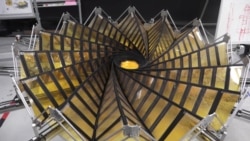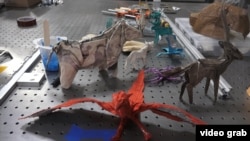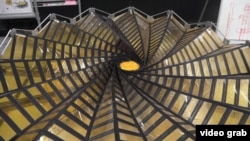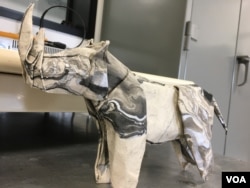Robert Salazar has been playing with origami, the Japanese art of paper folding, since he was 8 years old. When he sees a sheet of paper, his imagination takes over and intricate animals take shape.
"Seeing the single uncut sheet, it has everything you need to create all of the origami that have ever been folded. It is all in the single sheet so there is endless potential," Salazar said.
The endless potential of origami, folding a single sheet of paper into an intricate sculpture, reaches all the way to space.
Salazar’s 17-year experience with origami is appreciated at NASA's Jet Propulsion Laboratory. As a contractor and intern, Salazar is helping create objects that may one day be used in space exploration.
"Origami offers the potential to take a very large structure, even a vast structure, and you can get it to fit within the rocket, go up, then deploy back out again. So it greatly magnifies what we are capable of building in space," Salazar said.
Folding a large object into a relatively small space is not a simple task.
"A big challenge in origami design in general is that because all of these folds share a single resource, which is a single sheet ... everything is highly interdependent, so if you change just one feature it has an impact on everything else," Salazar said.
"One of our guide stars really is keep it as simple as can be," said Manan Arya, a technologist at NASA's Jet Propulsion Laboratory. "Don't add unnecessary complexity because every piece of complexity, every piece of hardware you add, that ends up being another potential point of failure."
Starshade
Folding an object the size of a baseball diamond so that it could fit into a rocket is the goal of a NASA project called Starshade.
Once it opens in space, Starshade would allow a space telescope to better see the planets around bright stars.
"Seeing an exoplanet next to its parent star is like trying to image a firefly next to a search light, the searchlight being the star," said Arya, who is working on the Starshade project. "Starshade seeks to block out that starlight so you can image a really faint exoplanet right next to it."
Origami robot
Origami is also used in designing a robot called the Pop-Up Flat Folding Explorer Robot, or PUFFER. It has a body that can fold itself flat and roll under small spaces. PUFFER has been tested on desert terrains and snowy slopes. It may one day end up on a mission to another planet.
"It [PUFFER] is to explore environments otherwise inaccessible to a robot that could not fold itself to fit inside these cracks, [to] explore cave systems, could be other planets, even on our own," Salazar said.
Origami antenna
Another application for space origami design is to pack an antenna into satellites the size of a briefcase, called CubeSats.
"The bigger the antenna you have, the more gain your antenna has, so it is useful to have a big antenna that gets packaged into this tiny space that unfolds out to be a large antenna. The biggest CubeSat antennas right now are about half a meter," Arya said.
Unexplored territory
There are also largely unexplored surfaces that can utilize origami concepts in designing new technologies.
"So often, origami design has been tailored toward materials that are already lying flat," Salazar said. "But there is actually a vastly, a much larger field of application for which the surfaces are not flat, so they could be parabolic. They could be spherical. They could be many combinations of doubly curved surfaces coming together. All of these things can also be folded."
In the current origami-inspired technologies being developed at NASA's Jet Propulsion Laboratory, there is a graceful beauty to the folding and unfolding of designs such as the Starshade, which unfurls into what looks like a sunflower. In origami, Salazar said, art, science and engineering are only superficially different.
"Really, when it comes down to it, you're looking at the world," he said. "You're making observations. You're finding patterns in these observations. [You're] developing an understanding of what you see, then using that understanding to create. And when you're creating, [it] can either be creating with the intention of solving a physical problem or it could be nonphysical. It could be aesthetic. You're trying to find a particular impact on people when they see your work. So really, the practice is the same."
In origami, Salazar said art, science and engineering are quite similar. They draw on making observations and creating something that produces an impact.












